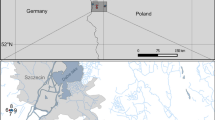Abstract
The structural parameters of phytoplankton in the estuarine region of a small tributary (Ild River) were studied in 2009–2011 and compared with the adjacent sections of the free-flowing section of the river and the pelagic zone of the Rybinsk Reservoir. Phytoplankton of the mouth estuarine region of the Ild River is characterized by high floristic and specific richness, biomass and coenotic diversity. With an increase in water temperature and a decrease in the water level in the reservoir, an increase in floristic richness, biomass, and the degree of similarity of the ratio of large taxonomic groups of algal communities of ecotone and border zones were observed in the mouth area of the tributary.



Similar content being viewed by others
REFERENCES
Bolotov, S.E., Krylov, A.V., Tsvetkov, A.I., Sokolova, E.A., and Poddubnyi, S.A., Water masses and zooplankton of the backwater zone of the Rybinsk Reservoir tributary, Povolzh. Ekol. Zh., 2012, no. 2, p. 134.
Ermokhin, M.V., Problems and prospects of the study of boundary structures of biocenoses of rivers and reservoirs of river valleys, in Aktual’nye voprosy izucheniya mikro-, meiozoobentosa i fauny zaroslei presnovodnykh vodoemov (Actual Problems of Studying Micro- and Meiozoobenthos and Fauna of Thickets of Freshwater Bodies), Nizhni Novgorod: Vektor TiS, 2007, p. 101.
Ilmavirta, V., Phytoflagellates and their ecology in Finnish brown-water lakes, Hydrobiologia, 1988, vol. 161, no. 1, p. 255.
Kislov, A.V., Evstigneev, V.M., Malkhazova, S.M., Sokolikhina, N.N., Surkova, G.V., Toropov, P.A., Chernyshev, A.V., and Chumachenko, A.N., Prognoz klimaticheskoi resursoobespechennosti Vostochno-Evropeiskoi ravniny v usloviyakh potepleniya XXI veka (Prediction of Climate Resource Supply of the East European Plain under Conditions of Warming in the 21st Century), Moscow: MAKS-Press, 2008.
Kitaev, S.P., Osnovy limnologii dlya gidrobiontov i ikhtiologov (Fundamentals of Limnology for Aquatic Organisms and Ichthyologists), Petrozavodsk: Karel. Nauchn. Tsentr Ross. Akad. Nauk, 2007.
Korneva, L.G., Fitoplankton vodokhranilishch basseina Volgi (Phytoplankton of Reservoirs of the Volga River Basin), Kostroma: Kostromskoi pechatnyi dom, 2015.
Krylenko, I.N., Mathematical modeling of backwater phenomena in the confluence of Sukhona and Yug rivers, Vestn. Mosk. Univ., Ser. 5: Geogr., 2009, no. 1, p. 53.
Krylov, A.V., Tsvetkov, A.I., Malin, M.I., Romanenko, A.V., Poddubnii, S.A., and Otjukova, N.G., Communities of hydrobionts and the physical-chemical characteristics of the estuary area of inflow of a flat water basin, Inland Water Biol., 2010, vol. 3, no. 1, p. 59. https://doi.org/10.1134/S1995082910010086
Krylov, A.V., Tsvetkov, A.I., and Bolotov, S.E., The principles of zoning of estuarine areas of tributaries of reservoirs used in work, in Gidroekologiya ust’evykh oblastei pritokov ravninnogo vodokhranilishcha (Hydroecology of Estuarine Areas of Tributaries of Plain Reservoirs), Yaroslavl: Filigran’, 2015, p. 36.
Magurran, A., Ecological Diversity and Its Measurement, London: Croom Helm, 1992.
Metodika izucheniya biogeotsenozov vnutrennikh vodoemov (Method of Studying Biogeocenoses of Inland Water Bodies), Moscow: Nauka, 1975.
Odum, Eu.P., Fundamentals of Ecology, Philadelphia: Saunders, 1975.
Prokin, A.A. and Tsvetkov, A.I., Macrozoobenthos of river confluence areas, Povolzh. Ekol. Zh., 2013, no. 2, p. 200.
Resursy poverkhnostnykh vod SSSR (Surface Water Resources of the USSR), Moscow: Mosk. Otd. Gidrometeoizdat, 1973, vol. 10, book 1.
Risser, P.G., The status of the science examining ecotones, BioScience, 1995, vol. 45, no. 5, p. 318.
Rokhmistrov, V.L., Malye reki Yaroslavskogo Povolzh’ya (Small Rivers of the Volga Region in the Yaroslavl Oblast), Yaroslavl: Verkhnevolzh. Otd., Ross. Ekol. Akad., 2004.
Romanenko, A.V., Bacterioplankton, in Gidroekologiya ust’evykh oblastei pritokov ravninnogo vodokhranilishcha (Hydroecology of Estuarine Areas of Tributaries of a Plain Reservoir), Yaroslavl: Filigran’, 2015.
Rybinskoe vodokhranilishche i ego zhizn' (Rybinsk Reservoir and Its Life), Leningrad: Nauka, 1972.
Sakharova, E.G. and Korneva, L.G., Phytoplankton in the littoral and pelagial zones of the Rybinsk Reservoir in years with different temperature and water-level regimes, Inland Water Biol., 2018, vol. 11, no. 1, p. 11. https://doi.org/10.1134/S1995082918010157
Sanders, R.W. and Porter, K.G., Phagotrophic phytoflagellates, Adv. Microb. Ecol., 1988, vol. 10, p. 167.
Trifonova, I.S., Ekologiya i suktsessiya ozernogo fitoplanktona (Ecology and Succession of Lake Phytoplankton), Leningrad: Nauka, 1990.
Tsel’movich, O.L. and Otyukova, N.G., Hydrochemical characterization of the Ild River, in Ekologicheskoe sostoyanie malykh rek Verkhnego Povolzh’ya (Environmental State of Small Rivers of the Upper Volga Region), Moscow: Nauka, 2003, p. 51.
Tsvetkov, A.I., Krylov, A.V., Bolotov, S.E., and Otyukova, N.G., Physicochemical characterization of water of allocated zones of the estuarine area of a tributary, in Gidroekologiya ust’evykh oblastei pritokov ravninnogo vodokhranilishcha (Hydroecology of Estuarine Areas of Tributaries of a Plain Reservoir), Yaroslavl: Filigran’, 2015, p. 56.
Upravlenie vodnymi resursami v Rossii. Zakonodatel’noe regulirovanie i perspektivy (Water Resources Management in Russia. Legislative Regulation and Prospects), Moscow: Izdanie Gosudarstvennoi Dumy, 2014.
Wegl, R., Index für die Limnosaprobität, Wasser Abwasser, 1983, vol. 26, p. 1.
Zakonnov, V.V., Poddubnyi, S.A., Zakonnova, A.V., and Kas’yanova, V.V., Sedimentation in variable-backwater zones of Volga chain reservoirs, Water Resour., 2010, vol. 37, no. 4, p. 462.
Zakonnova, A.V. and Litvinov, A.S., Runoff of basin rivers, in Ekologicheskoe sostoyanie malykh rek Verkhnego Povolzh’ya (Environmental State of Small Rivers of the Upper Volga Region), Moscow: Nauka, 2003, p. 13.
ACKNOWLEDGMENTS
We are grateful to Institute for Biology of Inland Waters, Russian Academy of Sciences, staff members A.V. Krylov, S.E. Bolotov, and A.I. Tsvetkov for organizing studies in the Il’d River mouth section; to the crew of the expedition fleet and T.P. Zaykina for assistance in sampling in the Rybinsk Reservoir pelagial; and to E.S. Gusev for help in identifying g. Synura species under a scanning electron microscope.
Funding
The study was carried out as part of State Task no. АААА-А18-118012690096-1.
Author information
Authors and Affiliations
Corresponding author
Ethics declarations
The authors declare that they have no conflict of interest. This article does not contain any studies involving animals or human participants performed by any of the authors.
Rights and permissions
About this article
Cite this article
Sakharova, E.G., Korneva, L.G. Influence of Temperature and Water Level on the Phytoplankton in the Estuarine Zone of the Rybinsk Reservoir Tributary. Inland Water Biol 12 (Suppl 2), 25–32 (2019). https://doi.org/10.1134/S1995082919060117
Received:
Revised:
Accepted:
Published:
Issue Date:
DOI: https://doi.org/10.1134/S1995082919060117




